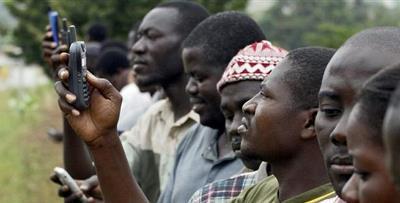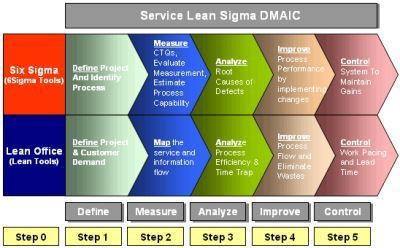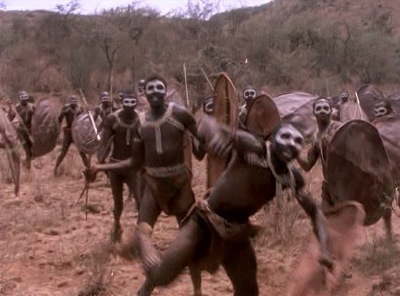Jeremie Averous's Blog, page 118
July 8, 2014
New Africa Mobile Phone Statistics – Expect the Fourth Revolution to Spread Like Wildfire
Gallup published some extremely striking statistics of mobile phone penetration in Africa. In most African countries, more than two-third of the households have a mobile phone in 2013!! And in a number of countries that can be considered to be quite poor (Uganda, Ivory Coast etc.), more than 75% of the households have one!
 This is an incredible penetration rate which shows that today, owning a mobile phone is probably considered to be a basic need by most of humankind.
This is an incredible penetration rate which shows that today, owning a mobile phone is probably considered to be a basic need by most of humankind.
It is also a sign of hope that access to significantly better communication capabilities will foster the development of Africa economies.
The other statistics that is extremely interesting in this paper is the following:
 This confirms that mobile phone ownership is considered a must even by the poorest and that it is not just a fancy equipment for rich people. A Revolution has started. We probably have not seen its consequences yet, but it is coming. And it will surprise us.
This confirms that mobile phone ownership is considered a must even by the poorest and that it is not just a fancy equipment for rich people. A Revolution has started. We probably have not seen its consequences yet, but it is coming. And it will surprise us.
Related post: How the Fourth Revolution Reaches every Corner of the Planet.

July 5, 2014
How Most Consulting Projects Fail For Not Taking Into Account Emotional Needs
“Why do most consulting projects fail? The reason is, processes (read: consultants) don’t normally link the outcomes of the project to the emotional needs of the people involved. How the little things they do, affect other people. This is where organizations with an entrepreneurial mindset have a powerful advantage.” – Hugh MacLeod.

Will this improvement method touch the hearts of the contributors?
Consultants conventionally come with great rational methods to improve things, and often do fail in their implementation. Because clearly, they don’t touch the heart of people when it comes to changing. And it is not by developing even more rational methods – or putting nice, attractive colors on complicated diagrams – that they will get the required emotional involvement.
The more I am participating to change programs, or execution of projects, the more I realize that emotional connection is the single key that unlocks the potential of organization and enables change.
Do your emotional work first, create meaning, and just use rational methods as a useful support. Don’t do it reverse. That is the recipe for successful change and therefore, successful consulting.

July 3, 2014
Historical Perspective on the Development of Weak Ties
Following on our previous post on “How the Fourth Revolutions Enhances the Power of Weak Ties” I find interesting to observe the history of weak ties throughout the different periods we have identified in the Fourth Revolution book: the Hunter-Gatherer Age, the Agricultural Age and the Industrial Age.

In the Hunter-Gatherer Age, Weak Ties were inexistent
As clearly exposed by Jared Diamond in his latest book “The World Until Yesterday: What Can We Learn From Traditional Societies“, in the Hunter-Gatherer Age, weak ties did not exist. You were part of the tribe or not. If you were not part of the tribe we had to fight you as a basis (before any attempt at discussion). This is still observed with tribes that had never any contact withe the outside.
In the Agricultural Age, with the advent of Writing, Empires and Cities, weak ties developed, mainly within the wider urban community. Still the extended family (the ‘blood’) and unions between families remained extremely important and essential, before considering any additional relationships.
In the Industrial Age, with the advent of printing and long distance communication of ideas, weak links became much more important. There are a number of instances where weak ties played important roles in particular in the community of scholars, who were exchanging correspondence and ideas all over Europe. It also extended to the skilled workforce and artisans. However, because of the technical limitations, long distance weak links were still difficult to maintain and communication infrequent.
Finally the Fourth Revolution and the Collaborative Age will allow us to fully leverage our weak ties to a much wider and dispersed community of people.
Ideas are breeding through chance encounters with other ideas. They breed through our weak links. With these weak links becoming easier, more global and prevalent, how can the Collaborative Age not be an Innovation Age?

July 1, 2014
How the Fourth Revolutions Enhances the Power of Weak Ties
The Fourth Revolution value creation is all about releasing the power of weak ties. In our social environment we have strong and weak ties, depending on how frequently and tightly we maintain our relation to other people.
 Apparently the statistics is that we maintain on average a dozen very close contacts, about 150 medium to strong ties, and about 500 to 1,500 weak ties. Identification of this structure of our social network is not new, for example this paper on ‘The Strength of Weak Ties’ in the American Journal of Sociology in 1973.
Apparently the statistics is that we maintain on average a dozen very close contacts, about 150 medium to strong ties, and about 500 to 1,500 weak ties. Identification of this structure of our social network is not new, for example this paper on ‘The Strength of Weak Ties’ in the American Journal of Sociology in 1973.
The paper is a bit lengthy but the conclusion is clear: “weak ties [...] are seen indispensable to individuals’ opportunities and to their integration in communities; strong ties, breeding social cohesion, lead to overall fragmentation“.
Weak ties create opportunities. This is repeatedly demonstrated for example by people looking for new work as testified for example in this post “the power of loose ties“. Or by our common experience that often, opportunities come from people with whom we are only remotely connected.
The successful social networks that define the Fourth Revolution are all about making the usage of weak ties easier, quicker and more frequent. Think about Facebook, Twitter, LinkedIn. Their power lies not in the direct connections but in the “friends of our friends”.
The Collaborative Age is the Age where we leverage our weak ties.
More information? Link to a general discussion of Interpersonal ties and social networks structure on Wikipedia.

June 28, 2014
Why Management’s Job is to Build the Capability to Recover if Failures Occur
“Management’s job is not to prevent risk but to build the capability to recover when failures occur” – says Ed Catmull, president of Pixar. While it is possibly a bit stretched (why not prevent known risks if easy?), this value has a great value in the world of uncertainty we are leaving in.

Freak event – all resides in how senior leadership will now react!
This brings us to the need to have reserves to cater for unknown- unknowns, the fact that our environment is generally shaped by short events of major crisis, and many topics we have discussed at length in this blog.
This also indicates that it is essential that leaders of an organization are not completely swamped by the day-to-day operations but have spare capacity available to do this important job nobody else in the organization can do (because those generally in charge of Enterprise Risk Management do not have the level of authority to really consider disruptive events).
Senior leadership’s role is to be able to manage disruption in a positive way for their organization, when it happens, and this requires a lot of preparation. Because luck is not luck, it is just good preparation.

June 26, 2014
Why Internal Stability is So Important in an Unpredictable World
Following up on an idea from Robert Branche in ‘Les Radeaux de Feu’ (only available in French), living organisms have organized themselves in the face of the inevitable increase in unpredictability of the world by increasingly developing internal stability.

Penguins maintain internal stability (homeostasis) independently from the external conditions – which can be very unpredictable
This is the case very visibly in mammals: they are clearly the dominant species, they have resisted to many cataclysms, and they are at the same time the animals that maintain the most stable internal environment with a constant internal temperature, glucose levels etc. This is called homeostasis.
Robert Branche takes this observation in the realm of organizations, and concludes that homeostasis is a necessary condition to thrive in an ever more unpredictable world: internal stability is necessary to properly manage external changes. It is important to maintain that internal stability and not let oneself be too much driven by external conditions.
This comes with a warning however – according to Robert, “the existence of internal order and rules must not reduce uncertainty, but make its development and acceptance easier“. The organization should not disconnect itself from reality for the sake of maintaining its internal stability.
Still I find this idea very valid that the most successful organisms and organizations thrive in an evermore unpredictable world by maintaining internal stability, which gives them the capability to respond instead of just reacting. How stable is your organization internally in the face of external changes?

June 24, 2014
How to Detect Passion
The other day I was challenged on LinkedIn to give a definition to Passion. I gave the following: “a passion is something that keeps your mind busy even if you’re not at it“.
 We all need passion in our life and it is the root of our achievements – in any area where that is applicable. Passion is needed for us to have the courage, do the effort and the work that these achievements do require.
We all need passion in our life and it is the root of our achievements – in any area where that is applicable. Passion is needed for us to have the courage, do the effort and the work that these achievements do require.
How do we know we have uncovered a passion? Just because we can’t stop thinking about it – at all times and even when we would be supposed to be focused on something else.
Do you recognize yourself in this definition of passion?

June 21, 2014
Why You Should be Unreasonable (Sometimes)
“The reasonable man adapts himself to the world; the unreasonable one persists in trying to adapt the world to himself. Therefore all progress depends on the unreasonable man” – George Bernard Shaw.
 I stumbled upon that video of an pretty unreasonable man seen tracing the way in front of an icebreaker. (It turns out it is a piece of art by Guido van der Werve.). I find that it is an excellent image of what an unreasonable man can do. He traces the way and behind comes the rest of the world.
I stumbled upon that video of an pretty unreasonable man seen tracing the way in front of an icebreaker. (It turns out it is a piece of art by Guido van der Werve.). I find that it is an excellent image of what an unreasonable man can do. He traces the way and behind comes the rest of the world.
And it comes also to link the quote from George Bernard Shaw with the concept of Art. Art is being unreasonable and creating progress. It is possible to create Art in most instances and most areas. Therefore, all progress depends on the unreasonable man – the artist?
Link to the making of the film by Guido van der Werve, and an extract of the film (with the sound of the ice broken by the icebreaker!) on Youtube.

June 19, 2014
How Commitment Creates Magic
Commitment creates magic. I love this quote from Goethe which is worthwhile reading in its entirety.
 “Until one is committed, there is hesitancy, the chance to draw back. Concerning all acts of initiative (and creation), there is one elementary truth, the ignorance of which kills countless ideas and splendid plans: that the moment one definitely commits oneself, then Providence moves too. All sorts of things occur to help one that would never otherwise have occurred. A whole stream of events issues from the decision, raising in one’s favor
“Until one is committed, there is hesitancy, the chance to draw back. Concerning all acts of initiative (and creation), there is one elementary truth, the ignorance of which kills countless ideas and splendid plans: that the moment one definitely commits oneself, then Providence moves too. All sorts of things occur to help one that would never otherwise have occurred. A whole stream of events issues from the decision, raising in one’s favor
all manner of unforeseen incidents and meetings and material assistance, which no man could have dreamed would have come his way. Whatever you can do, or dream you can do, begin it. Boldness has genius, power, and magic in it. Begin it now.” – Goethe
Be bold. Commit and start now! Things will happen which you will not have anticipated!

June 17, 2014
Reunited with his Family 26 Years Later: Another Testimony of the Power of the Fourth Revolution
“Everything is at the tap of a button, but you need to have the will and the determination to wanting it“. This is the final quote from Saroo Brierley in this great video. It is a true story of an small Indian boy lost in India, adopted by an Australian family (he also adopted the accent!) and finally figuring out where he came from through his recollections and long searches on Google Earth. The fact that Google used the story to advertise their products does not change the inspiring nature of the story
The full story of Saroo Brierley is accessible on in this long and emotional article on Vanity Fair, ‘A Home at the End of Google Earth’.
We now have at our fingertips much more power than we realize. Power to discover and observe the world in a way that was not available a few years ago. Power to find our way in the world, by ourselves. It is available. We just need the determination. What if we used that power as we could?




